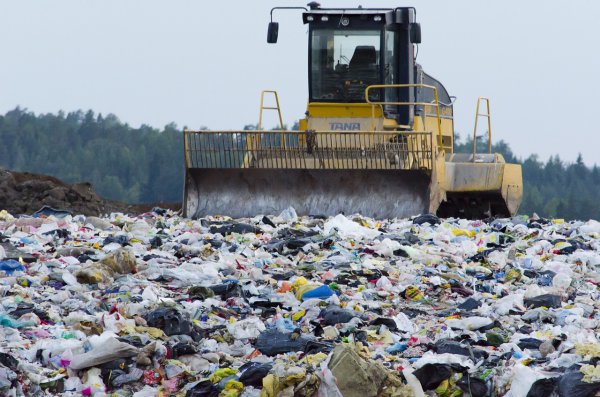As scientists and governments seek new ways to counteract the anthropogenic causes of climate change, one popular channel is waste management. In 2018, the United States generated 292.4 million tons of municipal solid waste (MSW). This is equivalent to 4.9 pounds of MSW per person per day—an unnervingly large statistic, and the highest per capita out of any country globally. Luckily, not all of this waste is going straight to the landfill. According to the United States Environmental Protection Agency (EPA), 32.1% of the country’s MSW was recycled or composted in 2018. This number represents an upward trend in recycling and composting in the US, as illustrated by the recent EPA graph below:
Yet, the other two-thirds of the country’s generated MSW is still funneled to either a landfill site or is incinerated. Landfill sites and incineration plants both expel noxious chemicals and emit greenhouse gases (GHG) like carbon dioxide (CO2) and methane (CH4). They also diminish public health and degrade the environment through localized pollution, lowering water quality and destroying natural habitats for local species. GHGs also cause more wide-reaching effects. The following table from a September 2020 EPA report indicates the high levels GHG emissions that were emitted by the waste sector last year, the vast majority coming from landfill sites and incineration plants:
These GHGs reside in the earth’s atmosphere for long periods of time and spread across the globe, trapping solar radiation within the atmosphere and raising the earth’s surface temperature as a result. Put simply, in order to improve the physical well-being of both humans and animals, humans must create alternatives to the current waste management systems that currently predominate in the US.
Increasing the number of solid waste composting facilities nationally presents a possible solution. These composting facilities have been used in the past to process food and other natural wastes like yard trimmings. In 2018, yard trimmings made up the majority of all MSW composting in the US at over 52% of the total. But, the prospects of these composting facilities far outweigh their current uses.
In Sevier County, Tennessee, the Sevier County Solid Waste Composting Facility processes much more than yard trimmings. Established in 1991, Sevier Solid Waste, Inc.’s (SSWI) Composting Facility has become a leader in green waste management throughout the country, rivaling even the likes of San Francisco, which is known for its sustainable waste management. Compared to the US’s overall 32.1% of MSW composted or recycled, Sevier composts and recycles roughly 70% of the county’s generated waste. Thanks to its cutting edge composting facility, SSWI also diverts the majority of the county’s non-compostable or recyclable waste away from Class 1 landfills, which are the most toxic because they are filled with the least recyclable and biodegradable materials. Class 1 landfills emit the most GHGs as a result, so decreasing the amount of waste in these sites eases the environmental stress they produce.
SSWI’s Composting Facility works by utilizing a series of rotating drums, otherwise known as digesters, to more efficiently process waste. The waste churns in the digesters and, following the removal of larger inorganic materials, remains in the digesters for 28 days, where oxygen is restricted. This allows anaerobic microbes to digest the waste and turn it into useful compost (like mulch), which can be used to nurture vegetation, and to help prevent erosion and sediment runoff. And, because of this effective digesting process, local businesses and citizens do not even have to separate their recycling from their waste (save a small handful of important exceptions like electronics), as it can all be digested just the same. Sevier’s Composting Facility uses this process to generate over 50,000 tons of compost per year. That is roughly 0.2% of the US’s total compost production per year, all from a county with under 100,000 residents (as of 2019).
SSWI’s Composting Facility is just the beginning. But, as the rollout of digesters and other composting facilities continues at a slow pace, more work needs to be done in the interim to address the negative impacts of MSW. To start, individuals can purchase their own compost digesters to put in their yards or lots. These digesters don’t always utilize the same mechanism as the one in Sevier, but they do help reduce individual waste nonetheless. Additionally, local and state legislators must address MSW issues more aggressively considering the excessive GHG emissions landfills and incineration plants produce. Adopting policies that seek to increase composting and recycling capabilities on a town-to-town basis is a straightforward and productive way to help in the fight against climate change (not to mention it will reduce the number of landfill sites near local residences, which should be exciting in and of itself). As such, Sevier County poses as a case study from which governments can model their own local waste management systems after. The US has a ways to go, but a green solution is in sight.
Sources
Composting. (n.d.). Sevier Solid Waste, Inc. https://www.seviersolidwaste.com/composting
Facts and Figures about Materials, Waste and Recycling. (n.d.). United States Environmental Protection Agency. https://www.epa.gov/facts-and-figures-about-materials-waste-and-recycling/national-overview-facts-and-figures-materials#:~:text=These%20Facts%20and%20Figures%20are,25%20million%20tons%20were%20composted.
Greenhouse Gas Reporting Program (GHGRP). (n.d.). United States Environmental Protection Agency. https://www.epa.gov/ghgreporting/ghgrp-waste#2019-subsector
Impacts of Municipal Solid Waste. (2013). Chicago Metropolitan Agency for Planning. https://www.cmap.illinois.gov/about/2040/supporting-materials/process-archive/strategy-papers/waste-disposal/impacts
Labatut, R. A., Angenent, L. T., & Scott, N. R. (2014). Conventional mesophilic vs. Thermophilic anaerobic digestion: A trade-off between performance and stability? Water Research, 53, 249–258.
Maxey, A. (2018, May 14). What’s Wrong with Burning Our Trash, Anyway? Conservation Law Foundation. https://www.clf.org/blog/whats-wrong-with-burning-our-trash-anyway/
McCoy, E. L. (2014). Where Does All the Trash from Dollywood Go? To One of the World’s Best Composting Facilities. YES! Magazine. https://www.yesmagazine.org/environment/2014/08/28/sevier-county-composting/
Richard, T. L. (1992). Municipal solid waste composting: Physical and biological processing. Biomass and Bioenergy, 3(3–4), 163–180.
Trash Incineration More Polluting than Coal. (n.d.). Energy Justice Network. http://www.energyjustice.net/incineration/worsethancoal
Types of Anaerobic Digesters. (n.d.). United States Environmental Protection Agency. https://www.epa.gov/anaerobic-digestion/types-anaerobic-digesters

